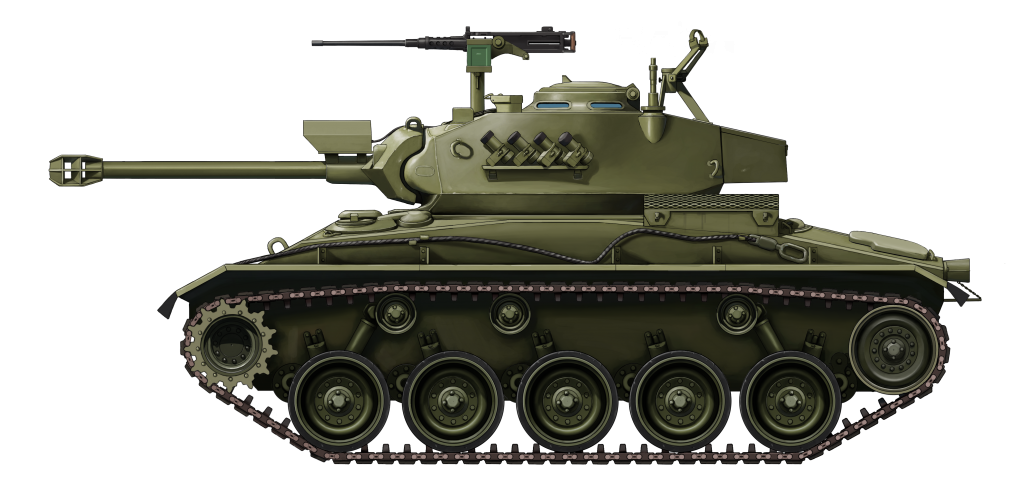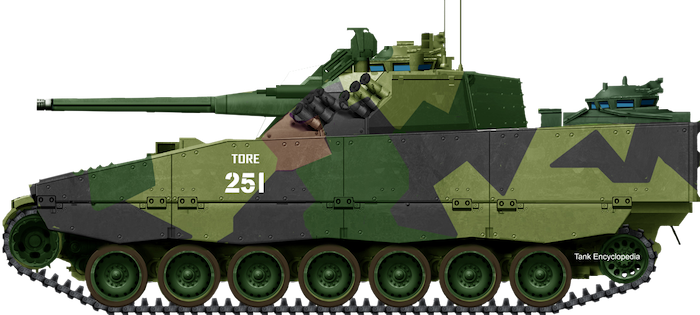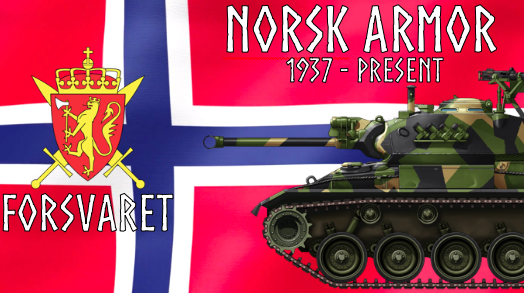Armored Vehicles Used by Norway From 1937 to the Present
Tanks in Service
World War II
Cold War
- NM-116 Panserjager
- NM-130 Bergepanser
- Stridsvogn & Stormkanon KW-III (Panzer III & StuG III in Norwegian Service)
- Stridsvogn M24 (M24 Chaffee in Norwegian Service)
Modern Era
Other

(“For everything we have. And everything we are”)
Photo: Wikimedia Commons
Norway is a country in the northern part of Europe, Scandinavia. It has a relatively small population of 5.3 million people (as of 2019). Norway has an odd geographical placement. It has an area that is slightly bigger than Germany’s, for example, it is very elongated, covering nearly 28 degrees of longitude, more than any other European country save for Russia. The country’s defining features is its mountainous terrain, dominated by the Scandinavian mountains, and its many fjords created by ancient glaciers. This leaves the country with only 3.3% arable land, nearly ten times less percentage-wise than France. This also contributes to the very low population density of Norway.
The local geographics have affected Norwegian military doctrine and equipment on a large scale, focusing in modern times on a more mechanized infantry direction due to the environment.

Historical Overview
Norway has a proud Viking heritage and has had a colorful military history that spans numerous centuries. Many wars were fought between Norway and its Scandinavian neighbors over various territories. There was even a war with Scotland over the Hebrides and the Isle of Man.
Come the 20th century, the country remained extremely rural and had experienced little industrial development. During the First World War, Norway was officially a neutral country, although it did ‘favor’ Britain. The Second World War was not so easy for Norway, falling to German invasion and occupation in 1940.
During the Cold War, Norway became a founding member of the North Atlantic Treaty Organization (NATO). It was a key ally to the west, sharing a border with the Soviet Union. Norway remains an important ally into the present day and has been the stage for large scale military exercises, such as Trident Juncture.
The Early Years
Norwegian armored vehicle history only began in the mid-to-late 1930s with the creation of 3 improvised armored cars built on commercial truck chassis. In 1938, they were bolstered with the purchase of a single L-120 from the Swedish company Landsverk. This tank was also known as the ‘Rikstanken’ in Norway, literally meaning ‘The National Tank’. These vehicles were the start of Norway’s relationship with mechanized warfare. The only action these vehicles took part in was extensive training exercises between 1938 and 1939.

WW2: Occupation
With the Second World War came the German invasion of April 9th,1940. The German Army seized all weaponry in storage at Gardemoen base, including the L-120 tank, rendering them useless in the defense of the country. Norway endured five years of German occupation, longer than France. An underground resistance sabotaged and destroyed key German resources throughout the occupation until Germany’s capitulation.
Despite the occupation that cast a shadow over Norway’s involvement in the war, Norwegian forces did have some success. The country’s greatest achievement during WW2 was the, albeit temporary, victory in the Battle of Narvik (April – June 1940). In this battle, Norwegian forces, fighting alongside British, French and Polish forces, managed to push German forces back to the Swedish border, freeing the valuable port of Narvik. Success was short-lived, however, as Allied forces evacuated Norway following the fall of France in late-June 1940. The German occupation of Norway the ensued. Throughout the remainder of the war, troops of the Free Norwegian Army, based in the UK, continued to fight for their country until the war’s end.

There were, of course, Norwegian sympathisers to the Nazi cause during the war, inspired by one of the most famous collaborators of the War, Vidkun Quisling, leader of the Norwegian Fascist party (Nasjonal Samling – National Union) and origin of the term ‘Quisling’. Quisling set a pro-nazi government, and many Norwegians became indoctrinated into the Waffen SS. This led to the raising of outfits like the infamous 5th SS Panzer Division ‘Wiking’ in January 1941 and the ‘Norwegian Legion’ (Den Norske Legion, Freiwilligen-Legion Norwegen) in June 1941. While the ‘Norwegian Legion’ was made up completely of Norwegian volunteers, ‘Wiking’ was formed from volunteers from not only of the Scandinavian countries (Denmark, Finland, Norway), but also Belgium and The Netherlands as well. Both the Legion and Wiking would serve on the Russian front, however, the Legion would be stood-down in 1943. Wiking would fight through the remainder of the War, surrendering to American forces in May 1945. Like many occupied countries, there was a strong resistance movement. Norwegian men that had joined the SS faced much persecution after the War and were labeled as traitors. Many were also put on trial.
The Occupation of Norway would only end with the capitulation of German forces at the end of the Second World War in Europe, May 1945. In their wake, surrendering German forces left behind vast swathes of equipment, from rifles to tanks, and even anti-tank guns like the 7.5cm PaK 40. The now free Norwegian Armed Forces would take advantage of these stocks. Around 60 Panzerkampfwagen IIIs of various types and 10 Sturmgeschütz IIIs were left behind, all of which would find a new use in the Norwegian Army in one way or another. The Panzers would be designated Stridsvogn KW-III, while the StuGs were known as the Stormkanon KW-III.

Cold War
Following the end of the Second World War, Norway gained a small force of 17 M24 Chaffees from the United States. Norway, however, was not resting easy. Once again, the country was facing the possibility of invasion, this time from the Soviet Union with which it shared a northern border. The focus of the Norwegian military at this time was defending their strategically important airfields. For this, three Dragoon Regiments were created; ‘DR 1’, ‘DR 2’ and ‘DR 3’. Each of these were split between various airfields. Initially, the garrison forces were equipped with the recycled Stridsvogn and Stormkanon KW-III due to a lack of available M24s. By 1951, Norway had begun to rebuild its military further, thanks largely to US-led Military Aid Programs (MAPs). Through this, Norway would eventually gain a 125-tank strong Chaffee force, resulting in the retirement of the KW-IIIs as the new tanks took over.
The M24 would form a large part of Norway’s early armored units, serving until the 1960s. The Chaffee has a royal connection in Norway as, between 1955 and 1957, Prince Harald (now King Harald V) served as part of a Chaffee crew during his conscription years.

During the Cold War, Norway would also come to receive large numbers of the US-made M113 Armored Personnel Carrier (APC). With both vehicles, indigenous upgrades would keep them in service longer than intended. In the case of the Chaffee, they were turned into the NM-116 ‘Panserjager’, an intensive upgrade program that gave them a new engine and more powerful armament. These upgrades kept the tanks in service until the late 1990s. The M113 fleet was upgraded and modified into many different variants. Just a couple of examples are the NM-135 Stormpanservogn, armed with a 20 mm cannon, and the Anti-Tank Guided Missile (ATGM) armed NM-142 Rakettpanserjager. The ‘NM’ in these designations literally means ‘Norwegian Model’. The upgrade work on the NM-116 and the M113 set a precedent in the military for upgrading vehicles. This would result in the appearance of many variants unique to Norway.

Norway became one of the founding members of NATO, opposing the Soviets during the entirety of the Cold War. Since Norway shared a border with the Soviet Union, a large demand for modern military equipment appeared.
Being a member of NATO opened the way for the importation of military equipment from Western allies. This led, in the early/mid-1960s, to Norway gaining and operating a fleet of US-made M48 Patton III tanks. In total, around 38 Pattons were operated, starting with the 90 mm gun-armed M48A2. These were later upgraded to M48A5 standard with the addition of the 105 mm L7 gun. In 1968, through its NATO links, Norway also gained a fleet of 172 German-built Leopard 1s. Like Norway’s previous armored vehicles, the Leopards went through various upgrades to keep them in service. The final incarnation, the Leopard 1A5, kept the tanks in service until 2011, ending a service life of 42 years. Norway also operated a large number of Leopard 1-based vehicles. This included the Bergepanzer 2, operated by Norway as the NM-217, as well as the NM-190 Broleggerpanservogn, an Armored Vehicle-Launched Bridge (AVLB) system based on the Leopard 1.

Modern Era
With the end of the Cold War, Norway began to modernize its military. In 1994, Norway became the first export customer of the Swedish CV90 Infantry Fighting Vehicle. These were largely brought in to replace the aging M113-based NM-135s. The vehicles were designated ‘Stormpanservogn’ CV9030N. The ‘30’ in the designation came from the fact that the standard 40 mm Bofors cannon was replaced by the Mk.44 Bushmaster II 30 mm autocannon. In total, 104 9030Ns were ordered in 1994 by the Norwegian Army. Starting in 2007, the vehicles saw active service in Afghanistan with the Norwegian contingent of the NATO-led International Security Assistance Force (ISAF). Following major successes in international operations, the CV9030 fleet was expanded and modernized with a large modernization project that was greenlit in 2012. Today the number of vehicles of the new standard, the 9030N Mk.3b, is 144.
Between 2003 and 2004, the military began to procure the German Leopard 2 main battle tank. For Norwegian service, these were designated as the Leopard 2A4NO. In total, 52 of these tanks were purchased, and at least 36 are still in operation today. Leopard 2-based support vehicles have also begun to replace the older Leopard 1-based models. For example, in 2019, the Norwegian military signed a deal with Germany to procure 6 Leopard 2-based Wisent 2s, a heavy armored recovery vehicle. Not only is Norway in the process of replacing old vehicles, but it is also in the process of buying entirely new vehicles like the K9 Thunder self-propelled gun to replace the aging M109A3. There is also a Leopard 2A4 modernization project in development.

Norway continues to play an important role in NATO. Between October and November 2018, the country was the scene of one of the largest military exercises since the Cold War; Operation Trident Juncture. This operation saw NATO Armies from across the world descend upon the harsh Scandinavian terrain of Norway to simulate a collective defense scenario.

A page by Mark Nash and Steffen Hjønnevåg.

NM-116 ‘Panserjager’, a domestically upgraded M24 Chaffee, 1970s.

Norwegian Leopard I Stridsvogneskadron, 6th Division, NATO winter exercises of 1988

Spv CV9030N ‘Tore’, featuring Norway’s ‘Splinter’ Camouflage scheme.

Norwegian Leopard 2A4NO in winter manoeuvrers, 2000s.
Sources
Clemens Niesner, Norge – Hærens Styrker, Vehicles of the Modern Norwegian Land Forces, Tankograd Publishing
forsvaret.no
www.globalfirepower.com
www.defence24.com
www.janes.com
warfarehistorynetwork.com

